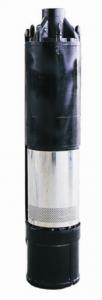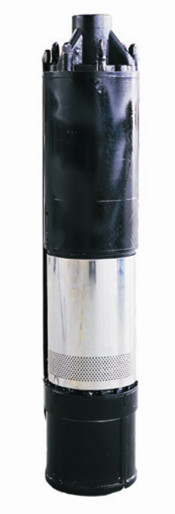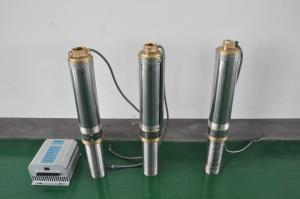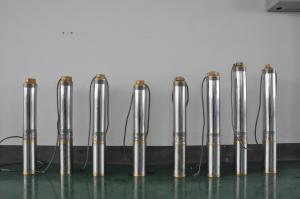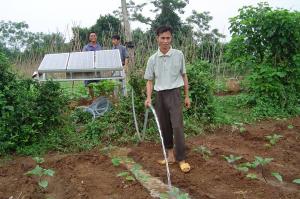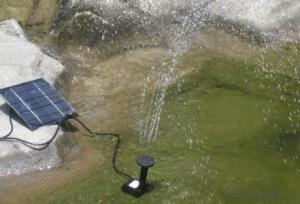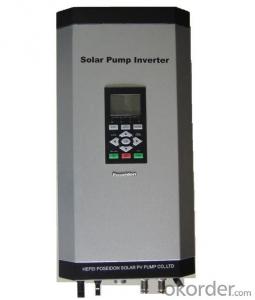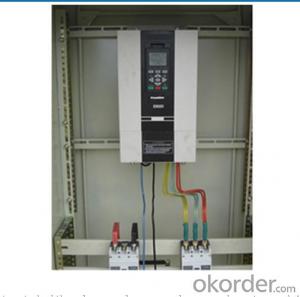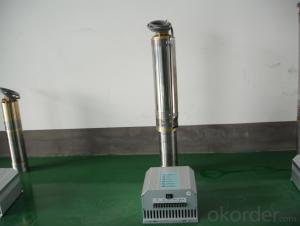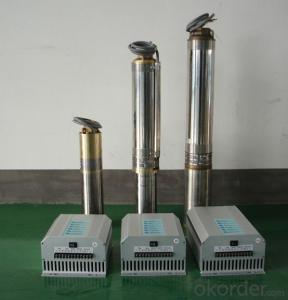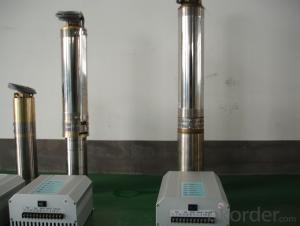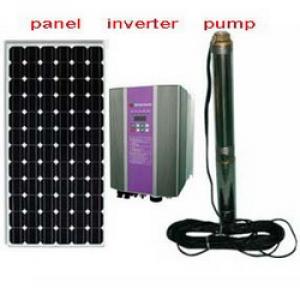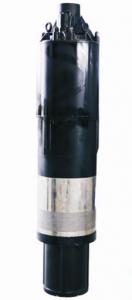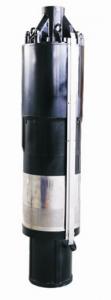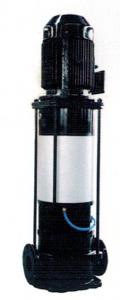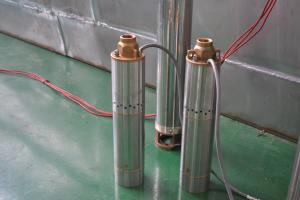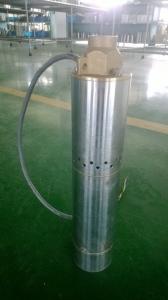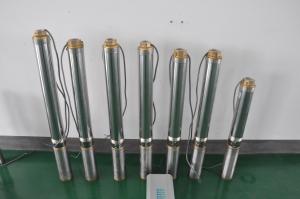12V DC Solar Water Pump 3DS-6-70
- Loading Port:
- China Main Port
- Payment Terms:
- TT OR LC
- Min Order Qty:
- -
- Supply Capability:
- 300 sets /month
OKorder Service Pledge
OKorder Financial Service
You Might Also Like
Product description:
Product: Solar water pump
Model:3DS-6
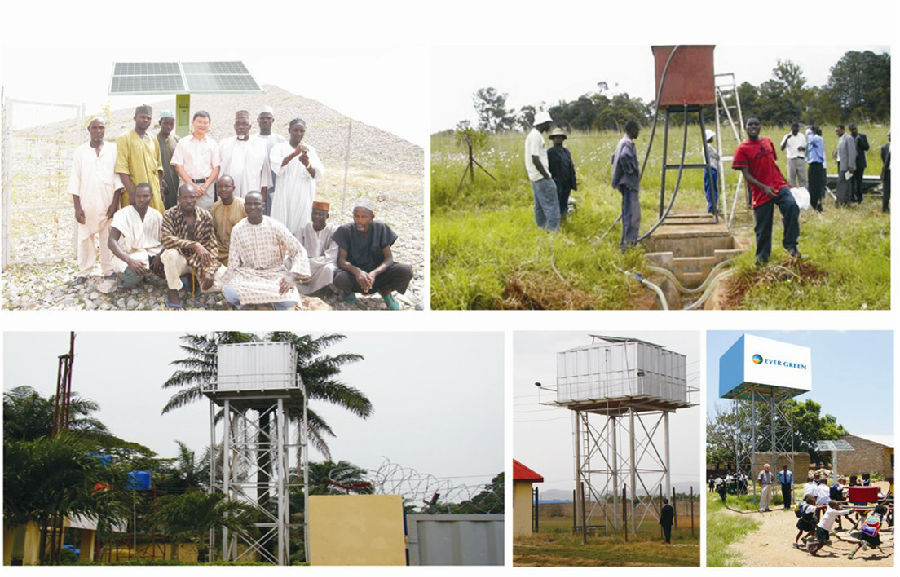 Appilication:
Appilication:
submersible pump
for deep well near a village or small farm
for drinking water of one village (100-300 people)
for watering a small farm
Product specification:
flow rate:1000 liter/ hour, 8000m3/day.
lift: 10m-70m
pump diameter: 140mm
well diameter more than 150mm
with BLDC motor, motor power:600W
but only need solar power:230W, our pump can save more than 50% solar panel power.
Material:
Pump inside: stainless steel and wearable nylon,it enables our solar pump to have 10 years sevice life.
Motor length:15cm,80% shorter than other motors. So that you can pump 80% more water by our solar pump.
Certification:
3 International patent
ISO9001
CE
Warranty:2 years
- Q: Can a solar pump be used to pump other liquids besides water?
- Yes, a solar pump can be used to pump other liquids besides water. The suitability of the solar pump for pumping different liquids depends on factors such as the viscosity and corrosiveness of the liquid.
- Q: How does the efficiency of a solar pump system vary with different water viscosities?
- Different water viscosities can affect the efficiency of a solar pump system. Viscosity refers to how thick or resistant a liquid, like water, is to flow. Generally, higher water viscosities can cause the efficiency of a solar pump system to decrease. This is because higher viscosity leads to more friction and resistance within the pump system. As the water thickens, it requires more energy to move and overcome the resistance, which can reduce the overall efficiency of the system. In addition, higher viscosity can also impact the performance of the pump itself. The pump is usually designed and optimized for a specific range of water viscosities. If the viscosity strays significantly from the ideal range, the pump may not be able to operate efficiently, resulting in lower performance and overall efficiency. It's worth noting that the effect of water viscosity on solar pump system efficiency may differ depending on the system's specific design and components. Some systems may be more adaptable to viscosity changes, while others may be more sensitive. Therefore, it's advisable to consult the manufacturer or system specifications to determine the recommended viscosity range for optimal performance and efficiency.
- Q: What is the payback period for a solar pump investment?
- The payback period for a solar pump investment is the amount of time it takes for the initial investment to be fully recovered through energy savings and other financial benefits. It is a crucial metric for evaluating the financial viability of such an investment. The actual payback period for a solar pump investment can vary depending on various factors such as the cost of the equipment, installation expenses, energy tariffs, and maintenance costs. Additionally, the amount of energy generated by the solar pump and the price of alternative energy sources in the region also play a significant role in determining the payback period. Typically, solar pump investments have relatively shorter payback periods compared to traditional pump systems powered by non-renewable energy sources. This is due to the lower operating costs associated with solar power, as sunlight is a free and abundant resource. Moreover, solar pumps require minimal maintenance and have a longer lifespan, reducing overall operational expenses. On average, the payback period for a solar pump investment ranges from 2 to 5 years. However, in some cases, it can be as short as 1 year or as long as 7 years, depending on the aforementioned factors. It is important to conduct a thorough financial analysis considering these variables to determine the specific payback period for a solar pump investment. Despite the initial capital required, a shorter payback period indicates a more financially attractive investment. Once the payback period is achieved, the solar pump investment will continue to generate energy savings and financial benefits for an extended period, contributing to long-term cost reductions and environmental sustainability.
- Q: What is the role of solar water pump?
- Solar water pump itself, reliable: photovoltaic power rarely used to move parts, reliable work.
- Q: Can a solar pump be used to pump oil or gas?
- No, a solar pump is not suitable for pumping oil or gas due to the different viscosity and pumping requirements of these substances.
- Q: Can a solar pump be used for water fountains or decorative purposes?
- Yes, a solar pump can be used for water fountains or decorative purposes. Solar pumps are designed to harness energy from the sun and convert it into power to operate water features. They can be a sustainable and efficient option for creating beautiful water displays or adding a decorative touch to a garden or outdoor space.
- Q: Are there any restrictions on using a solar pump in residential areas?
- There may be some restrictions on using a solar pump in residential areas depending on the local regulations and zoning laws. It is advisable to consult with the local authorities or homeowner's association to understand any specific guidelines or restrictions that may apply in your area. Some common restrictions may include noise limitations, height restrictions, setback requirements, and limitations on the installation of solar panels. Additionally, some areas may require obtaining permits or licenses before installing a solar pump. It is essential to ensure compliance with any applicable regulations to avoid any potential legal issues or penalties.
- Q: What is the maintenance required for a solar pump?
- The maintenance required for a solar pump typically includes regular cleaning of the solar panels to ensure maximum efficiency, checking and tightening of all connections, inspecting the pump for any signs of damage or wear, and monitoring the water levels to prevent any blockages or clogs. Additionally, it is important to regularly check the battery and controller to ensure proper functioning and replace any components as needed.
- Q: Are there any limitations to the type of control system that can be used with a solar pump?
- Yes, there are limitations to the type of control system that can be used with a solar pump. One limitation is the availability of sunlight. Solar pumps rely on solar panels to generate electricity, so if there is insufficient sunlight, the pump may not work optimally or at all. Additionally, the size and capacity of the solar panels also impact the pump's performance. Other limitations include the need for proper installation and maintenance, as well as the compatibility of the control system with the specific solar pump model. Overall, while solar pumps offer sustainable and efficient water pumping solutions, their control systems are subject to certain limitations.
- Q: How does a solar pump help in reducing the use of herbicides?
- A solar pump helps in reducing the use of herbicides by providing an alternative method for watering crops without the need for traditional, chemical-based herbicides. By utilizing solar energy to power the pump, farmers can efficiently irrigate their fields, preventing weed growth and reducing the reliance on herbicides to control weeds.
Send your message to us
12V DC Solar Water Pump 3DS-6-70
- Loading Port:
- China Main Port
- Payment Terms:
- TT OR LC
- Min Order Qty:
- -
- Supply Capability:
- 300 sets /month
OKorder Service Pledge
OKorder Financial Service
Similar products
Hot products
Hot Searches
Related keywords
